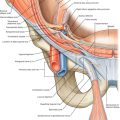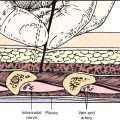CHAPTER 107
Phantom Limb Pain
Definition
Phantom pain refers to a painful sensation perceived in a body part that is no longer present subsequent to surgical or traumatic removal. It is most common after the amputation of a limb (i.e., phantom limb pain), but it has also been reported after the surgical removal of other body parts, such as breast, rectum, penis, testicles, eye, tooth, tongue, or lesion of peripheral or central nervous system [1]. Phantom limb pain is distinguished from stump pain, which is pain in the residual limb or stump, and phantom limb sensation, which is a nonpainful sensation of the absent part. Peripheral, spinal segmental, central, and psychological mechanisms are considered factors in the development of phantom limb pain, and an increasing number of studies with functional neuroimaging have suggested a central mechanism for phantom limb pain [2–5].
Although phantom limb pain is generally present within the first few days after an amputation, it can take several months or years to emerge. The reported prevalence of phantom limb pain differs considerably, ranging from about 40% to 90% [1,6]. However, phantom limb pain is less frequent in congenital amputation and loss of a limb early in childhood. The occurrence of phantom limb pain is independent of gender, age (in adults), level or side of amputation, dominance, and etiology of amputation.
In several reports, the intensity of pain remained constant but both the frequency and duration of pain attacks decreased significantly over time [7,8]. A small percentage of patients experienced a reduction in intensity of pain over time. Phantom limb pain leads to permanent disability in more than 40% of amputees, and pain persisting for more than 6 months is exceedingly difficult to treat.
Phantom limb pain has been reported to be significantly related to residual limb pain, physical activity, severity and duration of preamputation pain, noxious intraoperative inputs (such as pain brought about by cutting of tissues), acute postoperative pain, bilateral amputation, and lower limb amputation.
Symptoms
Pain is most prominent immediately after the operation; it is not static in nature and changes in quality over the years. Phantom limb pain is usually intermittent, but some patients report constant pain with superimposed exacerbations. The duration of an attack ranges from seconds or minutes to hours or days. Phantom limb pain is usually localized in distal parts of the absent limb, usually in the foot or hand.
The pain can be described as tingling, throbbing, aching, pins and needles, squeezing, stabbing, shooting, pinching, or cramping. Sometimes, the patients report that the amputated limb is positioned in a painful posture or that they sense spasms in the limb. The intensity as well as the quality of the pain varies greatly among patients from mild to severe. Phantom limb pain is triggered or worsened by physical (e.g., rainy weather, low temperature, prosthetic use, urination, defecation, reduced blood flow, and muscle tension), psychosocial (e.g., attention), and emotional (e.g., anxiety and stress) stimuli. Phantom limb pain is not relieved with position.
Physical Examination
Physical examination is generally unrevealing. However, patients can sometimes identify specific points on the residual limb that trigger phantom limb pain. Therefore the residual limb should be assessed for any sources of pain or trigger areas. The residual limb is examined for neuromas, cysts, bursae, bone spurs, or sites of excessive pressure. Other precipitating factors should be searched for, such as an ill-fitting prosthesis or mechanical stimulation.
Local problems, such as a herniated disc or spinal disease emitting sensations into the phantom limb or neuroma, can cause neuropathic pain. A comprehensive physical evaluation with particular attention to the neurologic examination, including strength, range of motion, muscle stretch reflexes, and muscle tone, should be done to rule out any concomitant central or peripheral neuropathic pain.
Functional Limitations
Functional complications of phantom limb pain include sleep disorders, interference with prosthesis training and use, reduction in walking ability, inability to return to work, change in employment status, and limitation of participation in social activities. Patients with phantom limb pain experience a greater degree of despair, more symptoms of depression, less satisfaction with social relations, poorer psychosocial adjustment, and poorer quality of life than amputees who are unaffected [9].
Diagnostic Studies
The diagnosis of phantom limb pain is generally made clinically on the basis of history and physical examination. Plain radiography and ultrasonography are performed for the diagnosis of underlying conditions, such as neuroma, abscess, bursitis, bone spur or fragment, or nerve entrapment. Magnetic resonance imaging, electrophysiologic tests, or laboratory tests may be indicated if other diagnoses are suspected.
Nerve block may be attempted as a diagnostic tool to identify candidates for specific procedures. Various pain scales and psychometric questionnaires are used to assess severity, treatment effect, and disability.
Treatment
The treatments commonly used for phantom limb pain are listed in Table 107.1.
Initial
Patients should be taught before amputation that phantom limb pain is not a complication but a normal side effect of some amputations. Education about phantom limb pain reduces anxiety and distress in patients. The expected course of symptoms after amputation and during the prosthetic fitting process should be carefully reviewed with the patient. Preemptive analgesia in an attempt to prevent phantom limb pain by epidural or general routes during the preoperative and initial postoperative period has not been shown to be effective. Compression stockings or stump shrinkers during the early postoperative period can also be helpful.
Tricyclic antidepressants and anticonvulsants have long been considered to be the drugs of choice [1]. Controlled studies, however, showed conflicting data on the effect of tricyclic antidepressants in phantom limb pain [10,11]. Anticonvulsants such as carbamazepine, gabapentin, topiramate, and lamotrigine are effective.
Randomized controlled studies have demonstrated that opioids have analgesic efficacy in phantom limb pain and suggest an effect on cortical reorganization [12–14]. Morphine is effective in decreasing pain intensity in the short term [15]. Tramadol is an analgesic with both monoaminergic and opioid activity that is effective in long-standing phantom limb pain.
N-Methyl-D-aspartate (NMDA) receptor antagonists, such as ketamine and dextromethorphan, showed efficacy in controlling phantom limb pain [15,16].
Other pharmacologic interventions, such as beta blockers, topical capsaicin, nonsteroidal anti-inflammatory drugs, nonopioid analgesics, and botulinum toxin, have been suggested, but well-controlled trials have not been published.
Rehabilitation
Transcutaneous electrical nerve stimulation has long been considered an effective treatment modality; it can begin early in the postoperative period without significant side effects. However, a recent Cochrane review failed to find sufficient evidence to support the effectiveness of transcutaneous electrical nerve stimulation for phantom limb pain [17]. Heat and cold, manipulation, vibration, massage, and acupuncture can all be tried, but there is no evidence of their efficacy.
Several studies have reported positive results of biofeedback, including electromyographic biofeedback, thermal biofeedback, and muscle relaxation procedures [1,18]. Use of a prosthesis that provides sensory, visual, and motor feedback reportedly reduces phantom limb pain [19,20]. Sensory discrimination training or tactile stimulation has also been reported to reduce phantom limb pain with a reversal of cortical reorganization. Mirror therapy and motor imagery have been shown to decrease phantom limb pain, supporting a central mechanism for the presence of pain [2,4,21–23].
Psychological interventions such as relaxation technique, stress management, distraction, and hypnosis can also provide relief, although very few specific studies of patients with phantom limb pain were conducted.
Procedures
Regional anesthesia with local anesthetics, including plexus or nerve block, sympathetic block, and epidural block, can be applied to intractable phantom limb pain. A continuous perineural infusion of a local anesthetic was reported to be effective in preventing and decreasing phantom limb pain [24].
Surgery
Surgery is generally not indicated for phantom limb pain. Stump revision, such as neuroma resection, is indicated in selected patients with stump pain due to neuroma. The purpose of neuroma resection is relief of stump pain, not of phantom limb pain.
Spinal cord stimulation, dorsal root entry zone ablation, neurectomy, sympathectomy, dorsal rhizotomy, cordotomy, thalamotomy, and cortical resection of brain have been used in a few cases of intractable pain [25,26].
Potential Disease Complications
Phantom limb pain may cause significant disability. It keeps amputees from their usual activities and causes considerable interference with their daily, social, recreational, and work activities. The health-related quality of life of amputees with phantom limb pain is poorer than that of amputees without phantom limb pain.
Potential Treatment Complications
Side effects of pharmacologic treatment are well documented. Complications of regional anesthesia are systemic effects of local anesthetics, physiologic effects of the procedure (e.g., hypotension, inadvertent injection or block), and damage to adjacent structures. Spinal cord stimulation has few serious complications. Complications of surgical ablation techniques include Horner syndrome, dysesthesia, sudomotor paralysis, weakness, urinary complications, and respiratory problems. Selection of appropriate patients is important to successful surgical ablation.







